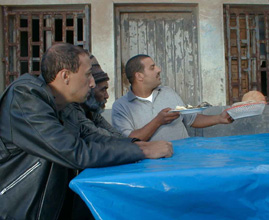Le cheval de vent
The Wind Horse
Daoud Aoulad Syad
Marokko/Frankreich 2001

| Delphi 12.02. 19.00 Arsenal 1 13.02. 12.30 CinemaxX 3 13.02. 18.15 Babylon 14.02. 22.00 |
Les Films Du Sud (Rabat)
Weltvertrieb: P.O.M. Films 7,
rue de la Convention, 93100 Montreuil
Tel.: (33-01) 49 88 18 42, Fax: 49 88 70 73
e-Mail: pom.films@libertysurf.fr
Buch: Ahmed Bouanani
Kamera: Thierry Le Bigre
Musik: Youness Meghri
Schnitt: Andrée Davanture
Darsteller: Mohamed Majd, Faouzi Bensaïdi,
Mohamed Belfquih, Driss Essalah
Format: 35mm, 1:1.85, Farbe
Länge: 86 Minuten, 24 Bilder/Sek.
Sprache: arabisch
Aoud rih ist die Geschichte der Freundschaft zwischen einem alten und einem jüngeren Mann. Sie spielt sich im Stil eines Roadmovies ab, und ein Motorrad mit Seitenwagen ist das Gefährt. Vor dem Hintergrund stumpfer Alltagsroutine erwachen Poesie und Phantasie zum Leben. Tahar, ein ehemaliger Schmied, verlässt das Haus seines Sohnes in der kleinen Stadt Salé, da er das Gefühl hat, nur noch eine Last, ein Ärgernis zu sein. Er beschließt, nach Azemmour zu faren, wo er vor seinem Ruhestand ein erfülltes, aktives Leben geführt hat. Dort will er dem Grab seiner geliebten Frau einen letzten Besuch abstatten. Diese Reise ist also auch eine Pilgerfahrt in seine Vergangenheit. Driss, der jüngere Mann, verlässt das Krankenhaus, ohne zu wissen, ob er geheilt oder unheilbar krank ist. Seine gesamte Energie wird von einem merkwürdigen Brief absorbiert, in dem ihm mitgeteilt wird, dass seine Mutter ein letztes Mal ihre Kinder zu sehen wünscht. Driss wurde jedoch von seinem älteren Bruder aufgezogen und hatte bisher geglaubt, dass seine Mutter starb, als er kaum drei Jahre alt war. Tahar und Driss führt die Ähnlichkeit ihrer Suche zusammen: Beide haben ihren Blick auf einen trügerischen Horizont geheftet und wollen ihn eher ersehnen als wirklich erreichen.
This is the story of the friendship that develops between an old man and a younger one. It takes the form of a road movie, in which the journey is made by means of a motorcycle and sidecar, and in which poetry and fantasy spring to life against a background of dull, everyday routine. Tahar is a former blacksmith who leaves his son’s house in the little town of Salé, where he feels he has outlived his usefulness and become nothing but a burden and a nuisance. He decides to react by paying one last visit to the tomb of the woman he truly loved in Azemmour, where Tahar lived a full and active life before his retirement. The journey he has decided to make is like a pilgrimage into his own past. Driss, the younger man, leaves hospital without knowing whether he is cured or condemned. He concentrates all his energy on the strange letter he has recently received, informing him that his mother wishes to see her children one last time. But Driss was raised by his older brother, convinced that his mother had died when he was barely three years old. What brings Tahar and Driss together is the nature of their common quest: each has set his sights on a chimeric horizon, and prefers to keep yearning for it than to actually reach it.
Daoud Aoulad Syad, geb. 1953 in Marrakesch (Marokko). 1981 Promotion in Physik. 1989 Teilnahme an einem Sommerkurs der FEMIS, erste Kurzfilme Karicature und Paris 13 juillet. Verschiedene Foto-Ausstellungen und Foto-Bände. Filme u.a. Adieu Forain (Forum 1999). Aoud rih ist sein zweiter Spielfilm.